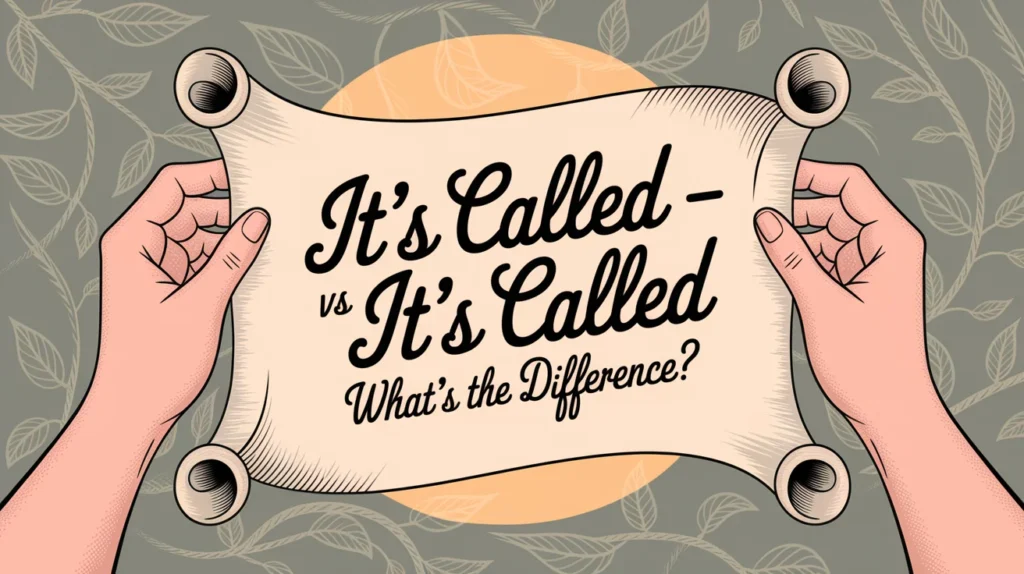When it comes to understanding the nuances of English, even small phrases like “it’s called” and “it called” can cause confusion. They sound similar but have very distinct meanings, and using the wrong one can lead to misunderstandings or mistakes. Whether you’re a native speaker or someone learning English, mastering these two phrases can elevate your language skills and make your communication more effective.
In this article, we’ll dive into the exact differences between these two expressions, providing clear explanations, real-life examples, and helpful tips to ensure you use them correctly every time. Understanding these differences will also make your writing and speech more accurate and precise, which is essential for building trust and authority in communication.
What Does “It’s Called” Mean?
“It’s called” is a contraction of “It is called.” This phrase is used to identify or name something, whether it’s a person, place, object, or concept. It’s a common expression used in both casual and formal language, especially when explaining or defining something.
Grammatical Breakdown
- It’s = This is the contraction of “it is” (subject + linking verb).
- Called = The past participle form of the verb “call,” which is used here in the passive voice to describe the name of something.
When using “it’s called”, the phrase is in the passive voice because you’re not focusing on the action but the result—how something is referred to or labeled. This is typical in cases where you want to explain what something is, what it’s known by, or how it’s defined.
Examples of “It’s Called”
- “It’s called a bicycle.”
- This sentence introduces the name of the object. It tells us that the object is known as a bicycle.
- “This is called a paradox.”
- Here, we are defining the term “paradox” by explaining what it is called.
- “It’s called a wedding ring because it symbolizes eternal love.”
- In this case, we explain the reason behind the naming of a wedding ring.
When to Use “It’s Called”
- Naming Objects: When you’re introducing the name of something, whether it’s an everyday object or a more complex concept.
- Example: “It’s called a microscope.”
- Introducing Terms or Concepts: When defining or explaining a term or concept, like scientific or philosophical terms.
- Example: “It’s called quantum mechanics.”
- Giving Titles: This phrase is commonly used when giving titles to books, movies, events, or projects.
- Example: “It’s called the ‘Great Gatsby.'”
What Does “It Called” Mean?
“It called” is the past tense of the verb “call”. When used in this form, it means that the subject (in this case, “it”) performed an action, typically the act of calling. This phrase is used when describing an event or action that has already occurred.
Grammatical Breakdown
- It = The subject performing the action.
- Called = Simple past tense of the verb “call,” indicating that the action happened in the past.
In this case, “it called” isn’t about naming or defining something; rather, it refers to an action that the subject took in the past. Whether it’s calling someone on the phone, signaling something, or making an announcement, this phrase emphasizes the action of calling.
Examples of “It Called”
- “It called me at midnight.”
- Here, the subject (presumably a phone or a system) is performing the action of calling.
- “It called for a celebration after the success.”
- This usage refers to the necessity or suggestion of celebrating after something happened.
- “It called attention to the issue.”
- In this example, the phrase indicates that “it” (perhaps a person or event) brought attention to something.
When to Use “It Called”
- To Describe Actions in the Past: When describing something that has already taken place, particularly actions such as making a call, signaling, or alerting.
- Example: “It called for immediate action.”
- In Figurative Use: The verb “call” can also be used figuratively to mean asking for or requiring something, as seen in phrases like “it called for.”
- Example: “It called for a drastic change in the company’s approach.”
- In Storytelling or Narrative: In both formal and informal storytelling, “it called” might be used to describe events or actions that occurred.
- Example: “It called for an explanation after the unexpected incident.”
Key Differences Between “It’s Called” and “It Called”
At first glance, “it’s called” and “it called” may seem quite similar, but their meanings and uses are fundamentally different.
1. Grammatical Structure
- “It’s called” = Passive voice, used for naming, defining, or explaining what something is referred to.
- “It called” = Active voice, describing an action performed by the subject in the past.
2. Usage Context
- “It’s called” is used when defining or naming something, whether it’s an object, term, or concept.
- “It called” refers to an action taken by the subject in the past, often related to calling, signaling, or asking for something.
3. Focus of the Sentence
- In “it’s called,” the focus is on the name or label given to something.
- In “it called,” the focus is on the action that was performed in the past.
Common Mistakes to Avoid
- Using “it called” when you mean to define something. For example, saying “It called a computer” instead of “It’s called a computer.”
- Confusing “it’s called” with “its called”—the correct form is “it’s called” (with the apostrophe), which stands for “it is called.” “Its” (without the apostrophe) is a possessive pronoun.
Practical Examples in Everyday Language
Understanding the correct use of “it’s called” and “it called” becomes easier when we apply these phrases in real-life conversations.
Example 1: Naming Objects
Incorrect: “It called a pencil.” Correct: “It’s called a pencil.”
In this case, we use “it’s called” to name the object (pencil). It’s a straightforward definition.
Example 2: Describing Past Actions
Incorrect: “It’s called me at noon.” Correct: “It called me at noon.”
Here, “it called” is used to describe the action of calling, which took place in the past.
Frequently Asked Questions
1. Can “It Called” Ever Be Used in Place of “It’s Called”?
No, “it called” cannot replace “it’s called.” These phrases have distinct meanings: one refers to an action, and the other refers to naming or identifying something.
2. Are There Any Exceptions to the Rule?
No, the difference is clear and should be followed in standard English. However, in informal speech or slang, some native speakers might blur the lines, but it’s not grammatically correct.
3. How Can I Avoid Mistakes Between These Two Phrases?
To avoid confusion, always think about whether you are referring to an action (use “it called”) or a name or definition (use “it’s called”). If you’re unsure, try substituting “it is” for “it’s” to check if the sentence still makes sense.
Conclusion: Mastering the Difference Between “It’s Called” and “It Called”
Understanding the difference between “it’s called” and “it called” can greatly improve your clarity and precision in both writing and speaking. By recognizing that “it’s called” refers to naming or identifying something and “it called” refers to a past action, you can ensure you’re always using the correct phrase in the right context.
By following these guidelines and practicing with real-life examples, you’ll feel more confident and effective in your communication. Mastering such small but important nuances in the English language helps build your authority and trustworthiness as a speaker or writer, making your language more precise and professional.
Frequently Asked Questions (FAQs)
1. What is the main difference between “It’s Called” and “It Called”?
The key difference is grammatical structure and meaning:
- “It’s called” (short for “it is called”) is used to name, define, or describe something.
- “It called” is the past tense of the verb “call”, meaning that “it” performed an action in the past, such as making a call or signaling something.
2. Can “It Called” ever replace “It’s Called”?
No. These two phrases have distinct meanings and are not interchangeable. “It’s called” is used to identify a name or label, while “it called” describes an action in the past.
3. How can I remember when to use each phrase?
A simple trick is:
- If you’re naming or defining something, use “It’s called”.
- If something took action in the past, use “It called.”
4. Is “Its Called” correct?
No, “Its called” is incorrect because “its” (without an apostrophe) is a possessive pronoun (belonging to “it”). The correct form is “It’s called”, where “it’s” is a contraction of “it is.”
5. Can “It Called” be used figuratively?
Yes. “It called” can be used in expressions like “It called for a celebration”, meaning that something required or suggested a certain action.

Mira Olive is a passionate spiritual writer dedicated to exploring the profound meanings behind angel numbers. With a background in numerology and a deep connection to the spiritual realm, Mira crafts insightful articles that guide readers on their journeys of self-discovery and personal growth.



